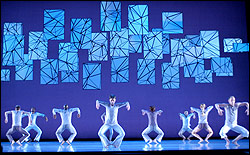Living in the provinces, it’s tough keeping track of the development of a major artist like Mark Morris. We see his Brooklyn-based company once a year, in a single program representing perhaps a 10th of its current repertory, which, in turn, is less than a 10th of all the works Morris has poured out since he started serious choreography in the late 1970s. Trying to get an idea of his current direction is like trying to read a billboard through the gaps between cars on a fast-moving freight train. Miss one annual visit, as I did in 2001, and the next time you see the company it’s like starting all over again.
Luckily, I got a chance to look at a video of the two works Morris is bringing to Seattle this week (8 p.m. Thursday, April 28–Saturday, April 30, at Meany Theater at the University of Washington; 206-543-4880): Mosaic and United, which I missed back in ’01, and the 2004 world premiere Violet Cavern. Even after two passes, I feel I’m only beginning to get a glimmer of how these two pieces “work”—and for that I’m profoundly grateful. Too much of the newer Morris works I’ve seen recently (that arbitrary filtering process I mentioned earlier) has been drawn from the pièces roses side of his repertory: genial, easy-on-the-eye-and-brain entertainments like Going Away Party and Dancing Honeymoon. We read about his pièces noir—the distinction is playwright Jean Anouilh’s—but they haven’t come to town as regularly.
We get a double dose of noir in this week’s program—not noir as in grim or gloomy; noir as in sumi paintings. There are vivid acrylics and soft pastels in the graceful costumes of Isaac Mizrahi (Mosaic) and Elizabeth Kurtzman (Cavern), and Michael Chybowski’s lighting is characteristically lambent, but Morris’ movement for both pieces is as abstract, economical, and severe as I’ve ever seen it.
Mosaic and United is the more approachable of the two. Morris has always expressed deep admiration for the “roots” period of American modern dance, when angular expressionism and almost vaudevillian “Oriental” gesture could coexist happily with fluttering veils and swooning romance. M&U, set to two multimovement string quartets composed in the mid-1930s by the American experimentalist Henry Cowell, offers strongly rhythmic pulses and solid blocks of sonorities to complement the movement of five dancers, whose gestures seem to pass power from one to another in patterns that fill the stage space. Twenty years ago, an intimate work like this might have more closely resembled one of Morris’ “community” works—like 1982’s New Love Song Waltzes or 1984’s My Party—in which one felt the interacting individuality of every dancer even in passages of full unison.
I haven’t seen that kind of “communal” evocation in Morris’ work of the last decade (again, my view is limited); if it has, in fact, diminished in importance in his expressive palette, it would hardly be surprising. The first decade or so in Morris’ adult repertory was created to an extraordinary extent on the bodies, and for the capacities, of a dozen or so dancers who were also Morris’ friends and lovers. The last of that wonderful bunch of idiosyncratic individuals is gone from the company, and although Morris still chooses dancers not for a classic “dancer’s body” but for their ability to meet his musical and technical demands, the sheer individuality of the company has dwindled with the years. It seems to me that Morris’ choreography has shifted to recognize that fact. Instead of creating movement for individuals within communities, he is creating dances for anonymous communities: organisms, processes— dramas without characters, stories without narrative but full of incident.
Violet Cavern, which debuted at the Brooklyn Academy of Music last summer, is an extreme form of such a work. If I were asked what it’s “about,” I would have to say that it’s about the numbers 2 and 3, with an occasional 1 and 5 for contrast. And it’s more about rotational symmetry than mirror symmetry. But, fear not, it’s also about despair so deep that you can barely feel at all any more, and a hectic energy that verges on hysteria. It’s about expanding the third expressive dimension of dance, using the brutal fact of gravity as a counterpoint to the perennial dance fiction of soaring weightlessness—out of a series of formalized gestures and poses, an emotional world arises. In this work, set to a commissioned score for piano, bass, and drums, I feel the sense of scale, the rigorous structure, the emotional amplitude that I experience in more audience-friendly Morris masterworks like Gloria and L’Allegro. This is big dance, as big as it gets in our time, and I’m grateful to have lived to see it.








